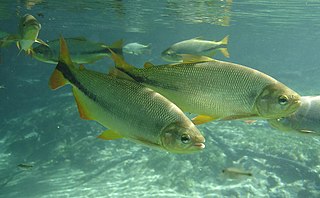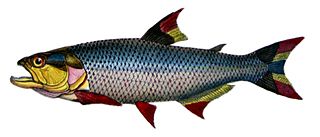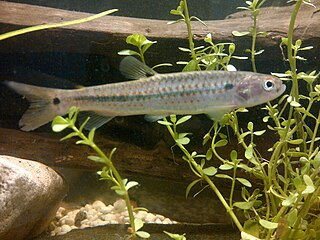
Tetra is the common name of many small freshwater characiform fishes. Tetras come from Africa, Central America, and South America, belonging to the biological family Characidae and to its former subfamilies Alestidae and Lebiasinidae. The Characidae are distinguished from other fish by the presence of a small adipose fin between the dorsal and caudal fins. Many of these, such as the neon tetra, are brightly colored and easy to keep in captivity. Consequently, they are extremely popular for home aquaria.

African tetras are a group of characiform fish exclusively found in Africa. This family contains about 18 genera and 119 species. Among the best known members are the Congo tetra, and African tigerfish.

Labeo is a genus of carps in the family Cyprinidae. They are found in freshwater habitats in the tropics and subtropics of Africa and Asia.

Orestias is a genus of pupfish. Older systematics classified them into the own family Orestiidae. They are found in lakes, rivers and springs in the Andean highlands of South America, and several species are considered threatened. They are egg-laying fish that feed on small animals and plant matter. The largest species can reach a total length of 27 cm (10.6 in), but most remain far smaller. Their most characteristic feature is the absence of the ventral fin, although this is shared by a few other pupfish. Despite their moderate to small size, they are important to local fisheries and a few species are farmed.

Rhamphochromis is a genus of East African haplochromine cichlids endemic to the Lake Malawi basin, also including Lake Malombe, Lake Chilingali, Chia Lagoon and upper Shire River. They mainly occur in offshore open waters, but a few species also near the coast. They are piscivores that typically feed on lake sardines and small utaka cichlids.

Pseudopimelodus is a genus of catfishes of the family Pseudopimelodidae.

The Victoria robber is a species of fish in the family Alestidae. It is found in Kenya, Rwanda, Tanzania and Uganda. It occurs in Lake Victoria and some surrounding streams.
Alestes stuhlmannii is a species of fish in the family Alestidae. It is endemic to the Ulanga River in Tanzania.

Brycinus is a genus of ray-finned fish in the family Alestiidae. Like other "African characids", they were formerly included in the Characidae but are actually somewhat more distantly related Characiformes.

Brycon is a genus of fish in the family Characidae found in freshwater habitats in Central and South America, ranging from southern Mexico to northern Argentina. Despite not being closely related to true trout, they are sometimes called South American trout. Members of the genus may also be referred to as piraputanga. They reach a maximum length of 11.9–79.5 cm (4.7–31.3 in) depending on the species involved. Some species perform seasonal breeding migrations.

Chrysichthys is a genus of claroteid catfishes native to Africa. Two fossil species are known. Chrysichthys macrotis, Van Neer, 1994, is known from the Miocene-Pliocene of the Albertine Rift in Uganda and Chrysichthys mahengeensis, Murray & Budney, 2003, is known from the Eocene of Mahenge, Tanzania.

Distichodus is a genus of freshwater fish in the family Distichodontidae found in Africa.

Arius is a genus of catfishes of the family Ariidae. The genus Arius is distributed in brackish and fresh waters of Eastern Africa and south to Southeast Asia.
Luciobarbus is a genus of ray-finned fishes in the family Cyprinidae. Its members are found in fresh and brackish waters of southern Europe, northern Africa, the wider Near East, the Aral and Caspian Seas, and rivers associated with these. Several species in the genus are threatened. Most species are fairly small to medium-sized cyprinids, but the genus also includes several members that can surpass 1 m (3.3 ft) in length and the largest, the mangar can reach 2.3 m (7.5 ft).

Salminus, popularly known as dorado or dourado, is a genus of relatively large, predatory freshwater fish from the family Characidae. They are native to large tropical and subtropical rivers in South America, and undertake migrations during the rainy season to spawn. They are very popular among recreational anglers and also support important commercial fisheries.
Tometes is a genus of fish in the family Serrasalmidae found in fast-flowing rivers in northern South America. Adults of all seven species in this genus are phytophagous, feeding primarily on aquatic plants in the family Podostemaceae.

Triportheus is a genus of characiform fishes from South America, including Trinidad, ranging from the Rio de la Plata basin to the basins of the Orinoco and Magdalena. Some are migratory.

Hoplias is a genus of fish in the family Erythrinidae found in Central and South America.

Piabucina is a genus of freshwater fishes found in Central and South America. The nine currently recognized species in this genus are:

Alestes baremoze, the pebbly fish or silversides, is a species of characin fish from the freshwater systems of northern and western Africa. It has some importance as a commercially exploited food fish.

















